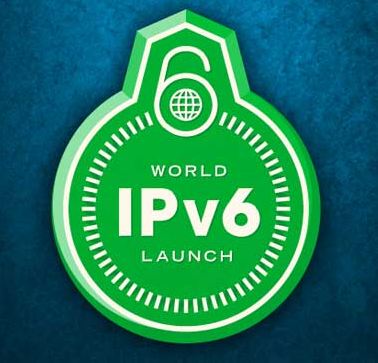This Wednesday, 2012-june-6, is the IPv6 Launch Day, which marks
the unofficial kickoff for the Internet transition from IPv4 to IPv6, which will
dramatically expand the number of addresses available for web sites, as well as
millions of mobile devices with Internet access.
Organized by the Internet Society, and building
on the successful one-day World IPv6 Day event held on 8 June 2011, World IPv6 Launch
represents a major milestone in the global deployment of IPv6. As the successor
to the current Internet Protocol, IPv4, IPv6 is critical to the Internet’s
continued growth as a platform for innovation and economic development.
In consequence, major Internet service providers
(ISPs), home networking equipment manufacturers, and web companies around the
world are coming together to permanently enable IPv6 for their products and
services by 6 June 2012.
As everybody knows, TCP/IP (Transmission Control
Protocol/Internet Protocol) is the technology that devices use to interact in
Internet. IP addresses are the unique identifier that devices use to communicate
to each other over the Global Internet. At the inception of the Internet, IP
version 4 (IPv4) was and is currently the most widespread protocol used to
communicate. By their binary nature, IP addresses are a finite resource (IPv4
assigns 32 bits for an IP address, and therefore has
232, i.e. 4 294 967 296 possible addresses) addresses. IPv4,
specifically, is approaching full deployment globally. The keeper of the free
address pool, the Internet Assigned Numbers Authority, (IANA), is fully depleted
of IPv4 resources. Also, the Asia Pacific Regional Internet Registry, 1 of the 5
regional registries that report to IANA, is fully depleted of IPv4
resources.
Therefore, to continue the operation of the
Internet, Internet Protocol version 6 (IPv6) was created.(IPv6 was developed by
the Internet
Engineering Task Force (IETF) to deal with this long-anticipated IPv4 address
exhaustion, and is described in Internet standard
document RFC 2460, published in
December 1998). This address space is vast–more than IPv4 and unlikely to be
depleted in the next 50 years (IPv6 uses 128-bit addresses, so it has an
address space of 2128 approximately 3.4×1038). Therefore,
it also eliminates the primary need for Network Address
Translation (NAT), which gained widespread deployment as an effort to
alleviate IPv4 address exhaustion.
However, IPv6 deployment has been
slow. While deployment of IPv6 has been accelerating, especially in the
Asia-Pacific region and some European countries, areas such as the Americas and
Africa are comparatively lagging in deployment of IPv6: the former because so
far they have enough Ipv4 addresses, the later because of the poor Internet
usage percentage. In December 2010, according to wikipedia (from I get most of
data of this comment), despite marking its 12th anniversary as a Standards Track
protocol, IPv6 was only in its infancy in terms of general worldwide deployment.
But, in my opinion, when the American Registry
for Internet Numbers, (ARIN) is almost running out of addresses and when smart
mobile devices and advanced peer-to-peer application (home devices no as much
because of NAT) are increasing the need of “real” IP addresses (without
NAT).
DataCentres and Networks Providers wishing to
grow must transition to include both IPv6 and IPv4, eventually transitioning
entirely to the new protocol. However, the important fact is that IPv4 and IPv6
are not compatible.
There are several mechanims for transitioning to
IPv6, since “tunneling” to proxying and address translation, but may be the most
deployed is “dual stack”. The later means that any device that wishes to be
“online” must be compatible with both protocols for some time to work properly.
To clarify, the world network operators will be “dual stacking” these protocols
for some time. This means that both IPv4 and IPv6 will concurrently run on the
same wires, even though they do not interact. In fact, any modern operating
system and/or browser is actually IPv6 ready today, and run both IPv4 and IPv6
simultaneous – check out of TCP/IP settings and you’ll see that you should have
both types of addresses already.
While both protocols will be running together for
some time, not all hardware or connection points support this concept of “dual
stacking.” It is imperative to know this as a data center operator as you begin
to assess either how to bring your current infrastructure online and/or
design/spec future builds so that all equipment selections support both
protocols
The main effect of IPv6 Launch Day is that a
consortium of major players in Internet infrastructure (between them is Tissat)
says parts of their infrastructure will begin supporting IPv6, the next
generation of the Internet Protocol (IP) that powers the Web.

No hay comentarios:
Publicar un comentario